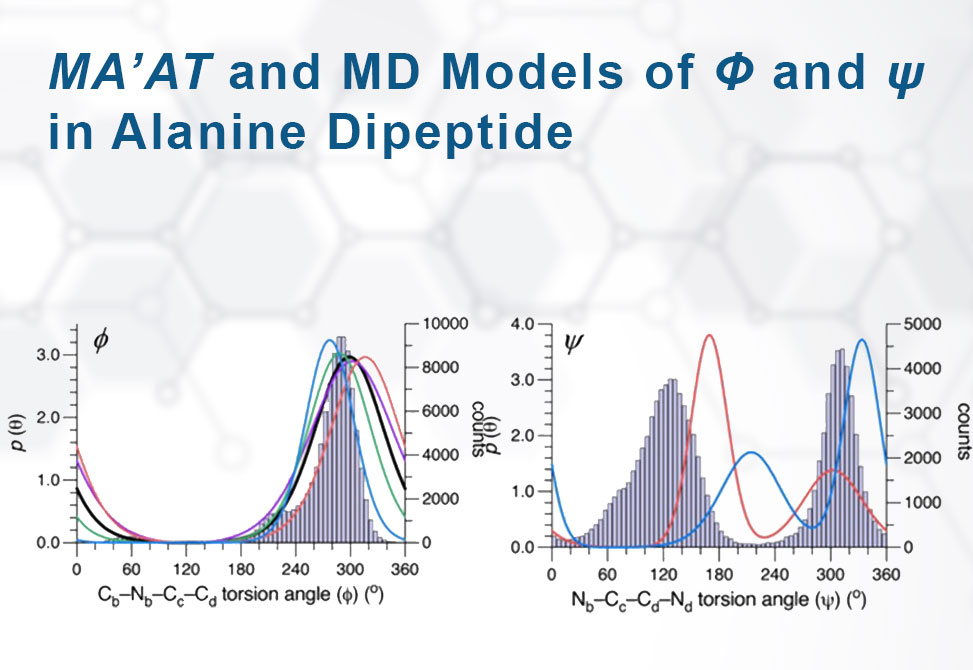Conformational Equilibrium
Reflecting work in the Serianni Group
The conformational behavior of alanine dipeptide, Ac-L-Ala-NHMe, 1, has long made it a model compound in molecular simulation studies. However, despite numerous investigations using molecular dynamics, MD, and quantum mechanical, QM, calculations, a rigorous, experimentally anchored picture of its backbone structure in aqueous solution remains unresolved. In a forthcoming study in Biochemistry, researchers from Professor Anthony Serianni's Lab at the University of Notre Dame apply the MA’AT method, named after the Egyptian goddess of truth, Ma’at, to extract conformational distributions from redundant NMR scalar, J, couplings. Originally developed for saccharides, this marks the first application of MA’AT to peptide analysis.
To perform this analysis, a series of 13C- and 15N-labeled isotopomers of 1 were synthesized, and a comprehensive set of scalar couplings sensitive to backbone torsion angles φ, Cb–Nb–Cc–Cd, and ψ, Nb–Cc–Cd–Nd, were measured via high-resolution NMR. These experimental values were then paired with DFT-calculated Karplus-like equations, parameterized from four distinct functional/basis set combinations and filtered for low-energy structures. The resulting coupling functions were fed into the MA’AT statistical framework, which computes angular probability distributions by minimizing deviations between experimental and predicted J values. The resulting solution-state models were benchmarked against 1 μs of explicit-solvent MD simulations using the AMBER FF19SB force field.
MA’AT analysis of the φ torsion angle yielded a well-defined, unimodal angular distribution centered around 299°, with a circular standard deviation, CSD, of approximately 44°. This solution-derived distribution closely aligned with the MD-determined mean of 288°, though the MA’AT model exhibited a superior fit to experimental data, RMSD = 0.47 Hz versus 1.13 Hz for MD. These results point to dominant solution conformations that reside within the C7eq and αR regions of φ/ψ space, with minor contributions from C5-like geometries. The reliability of this one-state φ model underscores the utility of redundant scalar coupling data and robust DFT parameterization in characterizing peptide backbone geometry in solution.
By contrast, the ψ angle proved more challenging to resolve. The available ψ-sensitive couplings—including vicinal, geminal, and one-bond interactions—exhibited modest dynamic ranges and were affected by secondary dependencies on φ. Nonetheless, the researchers in the Serianni Lab succeeded in constructing two-state ψ models using MA’AT by constraining angular dispersion, CSD, values during statistical modeling. The best-fitting two-state model featured distributions centered near 169° and 302°, in good agreement with the MD-derived ψ means of 119° and 309°. While neither solution model precisely replicated the MD results, both matched reasonably well in terms of population ratios, approximately 60:40, and demonstrated the feasibility of modeling multistate ψ equilibria from experimental data. The use of one-bond couplings, 1JCc,Hc and 1JCc,Cf proved critical in enabling these multistate fits.
In addition to φ and ψ, the members of the Serianni group also addressed the amide bond configurations ω1, Ca–Cb–Nb–Cc, and ω2, Cc–Cd–Nd–Ce, which can in principle adopt cis or trans geometries. By comparing three J-couplings per amide bond to values predicted by DFT for cis and trans configurations, the study confirmed a strong preference for the trans conformation in both cases. This result is consistent with expected kinetic barriers and supports the assumption that the amide linkages in 1 are conformationally restricted on the NMR timescale.
In summary, this work extends MA’AT analysis beyond carbohydrates and into the peptide realm, offering an experimental route to solution-phase backbone modeling. The φ torsion angle, supported by a wealth of J-coupling data and high-quality DFT parameterization, can be characterized with high confidence. Although ψ analysis remains more uncertain due to limited data and weaker torsion-coupling relationships, this study demonstrates that constrained multistate modeling can still provide informative insights. The authors note that future improvements in DFT-calculated one-bond couplings and expanded experimental coupling datasets will be essential for achieving high-precision ψ modeling in peptides and proteins. Ultimately, the application of MA’AT to peptide systems like alanine dipeptide marks a meaningful advance toward accurate, experimentally driven conformational analysis of biomolecules in solution.


